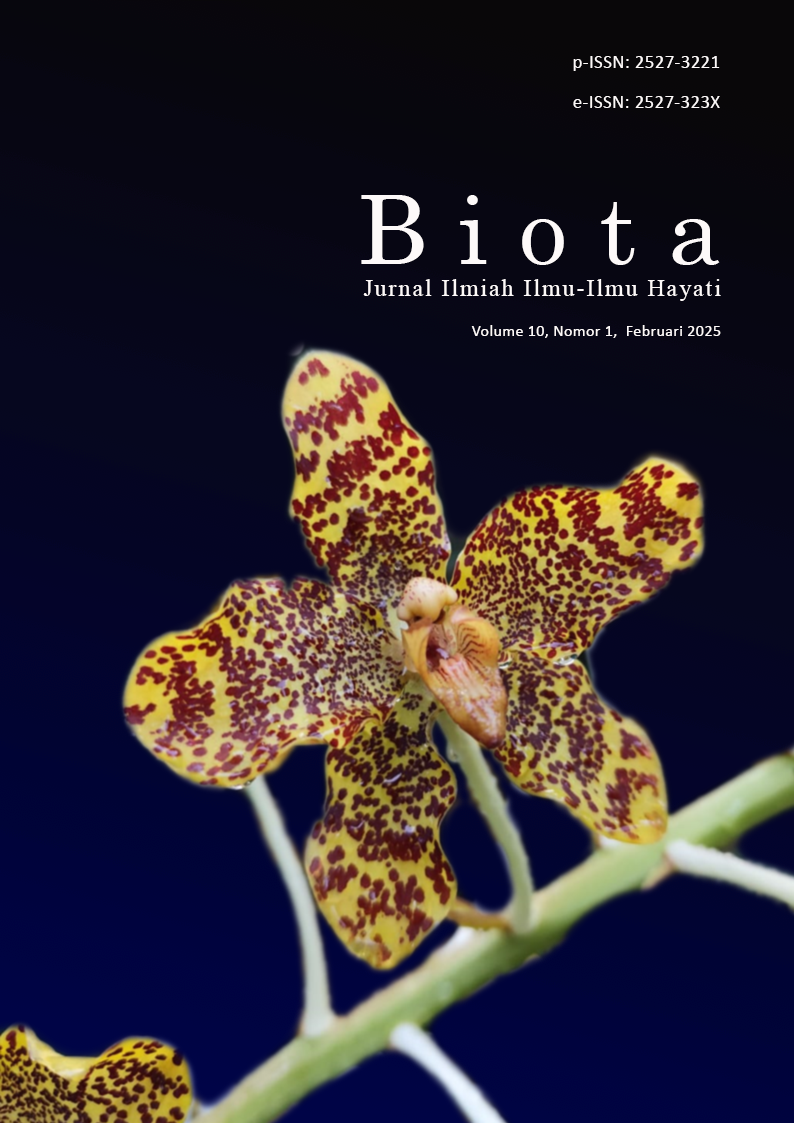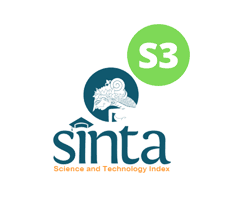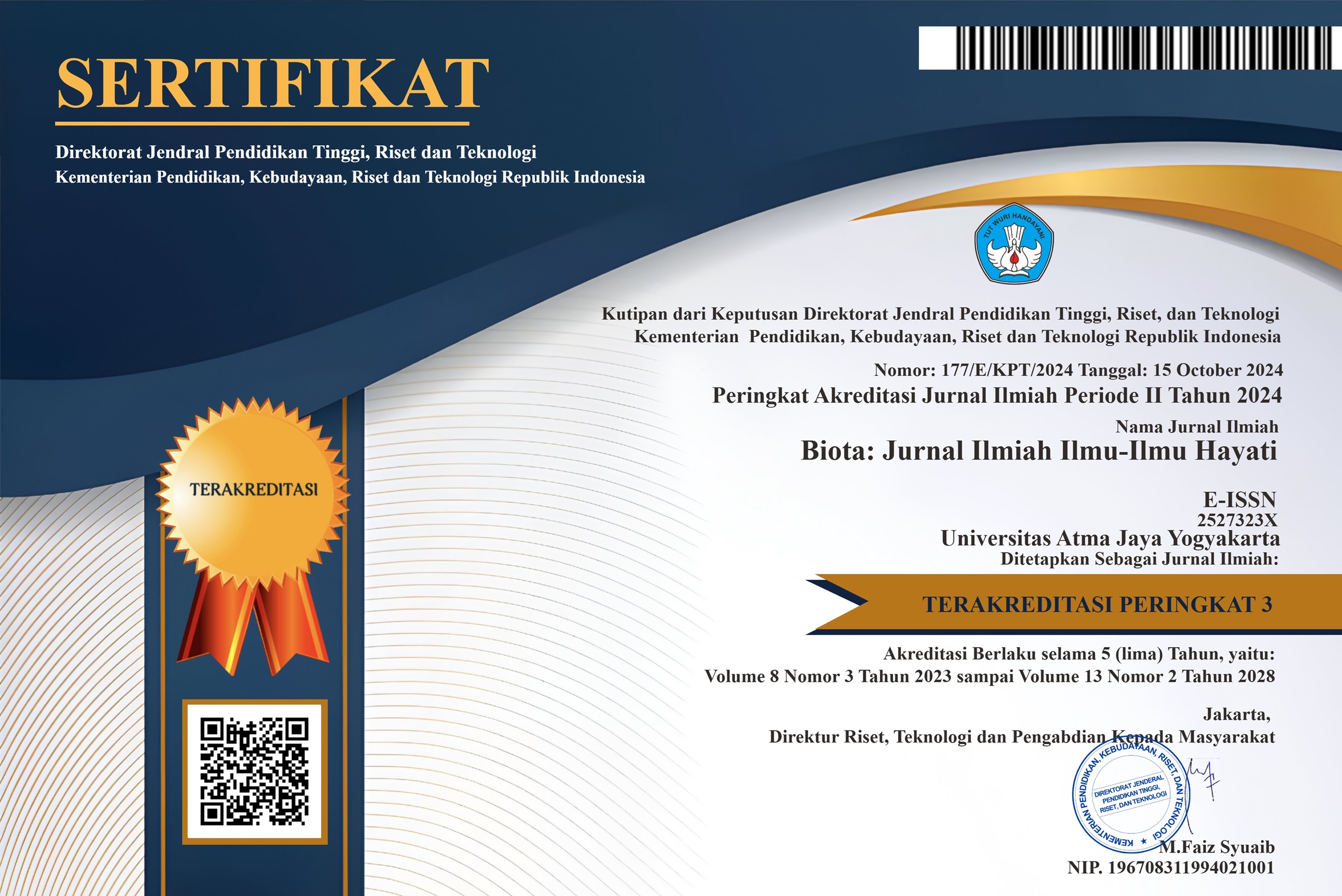Produksi Selulosa Bakteri Berbasis Limbah Kulit Pisang dan Limbah Kulit Pepaya dengan Penambahan Etanol
DOI:
https://doi.org/10.24002/biota.v10i1.8706Keywords:
Etanol, kulit pepaya, kulit pisang, selulosa bakteriAbstract
Limbah kulit pisang dan limbah kulit pepaya merupakan limbah buah hasil konsumsi yang cukup banyak dihasilkan di Indonesia. Potensi kandungan mineral dan gula yang terdapat di dalam kedua limbah ini dapat digunakan sebagai media fermentasi untuk memproduksi biomaterial salah satunya adalah selulosa bakteri atau nata. Pada penelitian ini akan diteliti perbandingan produksi selulosa bakteri dari bahan baku limbah kulit pisang dan limbah kulit pepaya yang disertai pengaruh produksi selulosa bakteri terhadap penambahan etanol. Penelitian ini menunjukkan bahwa kulit pisang dan kulit pepaya dapat digunakan sebagai bahan baku dalam produksi selulosa bakteri dengan yield tertinggi sebesar 9,33% diperoleh dari media limbah kulit pepaya tanpa adanya penambahan etanol. Sedangkan yield terendah nata sebesar 1,33% diperoleh dari media fermentasi kulit pepaya dengan penambahan 3% etanol. Penambahan etanol pada penelitian ini menghambat proses fermentasi dikarenakan tingginya konsentrasi etanol yang digunakan. Etanol yang semula pada penelitian ini diharapkan sebagai sumber karbon berubah menjadi senyawa toksik bagi pertumbuhan Acetobacter xylinum.
References
Abbaszadeh, S., Nodeh, H. R., & Alwi, S. R. W. (2018). Bio-adsorbent derived from papaya peel waste and magnetic nanoparticles fabricated for lead determination. Pure and Applied Chemistry 90(1): 79–92.
Agustin, Y. E., & Padmawijaya, K. S. (2018). Effect of acetic acid and ethanol as additives on bacterial cellulose production by acetobacter xylinum. IOP Conference Series: Earth and Environmental Science, 209(1): 1 - 5.
Alfarisy, M., & Rahmadhia, S. N. (2022). An Analysis of the Causes of Damage to Nata de Coco in the Fermentation Process. Journal of Agri-Food Science and Technology 2(1): 96–103.
Aprianto, S. (2019). Pengaruh Konsentrasi Bakteri dan Ph pada Proses Fermentasi Kulit Pisang menjadi Nata De Banana Peel. Program Studi Teknik Kimia, Fakultas Teknik, Universitas Muhammadiyah Surakarta.
Bari, L., Hassan, P., Absar, N., Haque, M., Khuda, M., Pervin, M., Khatun, S., & Hossain, M. (2006). Nutritional analysis of two varieties of papaya (Carica papaya) at different maturation stages. Pakistan Journal of Biological Sciences 9(1): 137–140.
Basuki, M., & Fahadha, R. U. (2020). Identification of The Causes Nata de Coco Production Defects for Quality Control. Journal Industrial Engineering 18(2): 175–181.
Betlej, I., Krajewski, K. J., Boruszewski, P., & Zakaria, S. (2021). Bacterial cellulose-properties and its potential application. Sains Malaysiana 50(2): 493–505.
Choi, S. M., Rao, K. M., Zo, S. M., Shin, E. J., & Han, S. S. (2022). Bacterial Cellulose and Its Applications. Polymers, 14(6): 1-44.
Deb, S., Kumar, Y., & Saxena, D. C. (2022). Functional, Thermal and Structural Properties of Fractionated Protein from Waste Banana Peel. Food Chemistry X, 13(100205): 1-9.
Gbenga-Fabusiwa, F. J., Jeff-Agboola, Y. A., Ololade, Z. S., Akinrinmade, R., & Agbaje, D. O. (2022). Waste-to-wealth; nutritional potential of five selected fruit peels and their health benefits: A review. African Journal of Food Science 16(7): 172–183.
Halim, Y., & Darmawan, C. R. (2021). Characteristics of Edible Film Made from Pectin of Papaya Peel. Reaktor 21(3): 116–123.
Hamid, N. A. A., & Zulkifli, N. Z. (2021). Papaya peels as source of hydro char via hydrothermal carbonization. IOP Conference Series: Earth and Environmental Science, 765(1), 0–11. Ini apakah no halaman benar?
Hasanin, M. S., Abdelraof, M., Hashem, A. H., & El Saied, H. (2023). Sustainable bacterial cellulose production by Achromobacter using mango peel waste. Microbial Cell Factories 22(1): 1–12.
Hwang, T. Y., Qi, H. A., Kin, C. M., Shing, W. L., Djearamane, S., & Thirunavukkarasu, C. (2021). Potential of Fruit Peel Waste in Growing Cyanobacteria Anabaena cylindrica. International Journal of Technology 12(4): 711–719.
Kazemi, M., Faranak, Doosthoseini, K., & Azin, M. (2015). Effect of Ethanol and Medium on Bacterial Cellulose (Bc) Production By Gluconacetobacter Xylinus (Ptcc 1734). Cellulose Chemistry Technology 49(6): 455–462.
Lahiri, D., Nag, M., Dutta, B., Dey, A., Sarkar, T., Pati, S., Edinur, H. A., Kari, Z. A., Noor, N. H. M., & Ray, R. R. (2021). Bacterial cellulose: Production, characterization and application as antimicrobial agent. International Journal of Molecular Sciences 22(23): 1–18..
Li, Y., Tian, C., Tian, H., Zhang, J., He, X., Ping, W., & Lei, H. (2012). Improvement of bacterial cellulose production by manipulating the metabolic pathways in which ethanol and sodium citrate involved. Applied Microbiology and Biotechnology 96(6): 1479–1487.
Liany, S. A., Syafira, W., Putri, A., & Khasanah, A. U. (2022). Effect of Bacterial Cellulose (BC) Formation on Various Substrate Variations and Combinations. Berkala Ilmiah Biologi 13(2): 13–20.
Lu, Z., Zhang, Y., Chi, Y., Xu, N., Yao, W., & Sun, B. (2011). Effects of alcohols on bacterial cellulose production by Acetobacter xylinum 186. World Journal of Microbiology and Biotechnology 27(10): 2281–2285.
Mohd Zaini, H., Roslan, J., Saallah, S., Munsu, E., Sulaiman, N. S., & Pindi, W. (2022). Banana peels as a bioactive ingredient and its potential application in the food industry. Journal of Functional Foods, 92(December 2021), 105054: 1-12.
Naritomi, T., Kouda, T., Yano, H., & Yoshinaga, F. (1998). Effect of ethanol on bacterial cellulose production from fructose in continuous culture. Journal of Fermentation and Bioengineering 85(6): 598–603.
Oladipo, B., Ojumu, T. V., Latinwo, L. M., & Betiku, E. (2020). Pawpaw (Carica papaya) peel waste as a novel green heterogeneous catalyst for moringa oil methyl esters synthesis: Process optimization and kinetic study. Energies 13(21): 1–25.
Pathak, P. D., Mandavgane, S. A., & Kulkarni, B. D. (2019). Waste to Wealth: A Case Study of Papaya Peel. Waste and Biomass Valorization 10(6): 1755–1766.
Pereira, M. A. F., Cesca, K., Poletto, P., & de Oliveira, D. (2021). New perspectives for banana peel polysaccharides and their conversion to oligosaccharides. Food Research International, 149(110706): 1-4.
Potočnik, V., Gorgieva, S., & Trček, J. (2023). From Nature to Lab: Sustainable Bacterial Cellulose Production and Modification with Synthetic Biology. Polymers, 15(16): 1-25.
Pratiwi, A., & Aryawati, R. (2012). Pengaruh Waktu Fermentasi Terhadap Sifat Fisik dan Kimia pada Pembuatan Minuman Kombucha dari Rumput Laut Sargasssum sp. Journal Marine Science 04:131–136.
Purwanto, A. (2013). Produksi Nata Menggunakan Limbah Beberapa Jenis Kulit Pisang. Universitas Katolik Widya Mandala Madiun 02: 332–341.
Rahman, S. S. A., Vaishnavi, T., Vidyasri, G. S., Sathya, K., Priyanka, P., Venkatachalam, P., & Karuppiah, S. (2021). Production of bacterial cellulose using Gluconacetobacter kombuchae immobilized on Luffa aegyptiaca support. Scientific Report 11(1): 1–15.
Rojas-Flores, S., Pérez-Delgado, O., Nazario-Naveda, R., Rojales-Alfaro, H., Benites, S. M., De La Cruz-Noriega, M., & Otiniano, N. M. (2021). Potential use of papaya waste as a fuel for bioelectricity generation. Processes 9(10): 1–11.
Sixin, L., & Congfa, L. (2004). Isolation and Control of Contaminating Fungi in Production of Nata de Coco. Department of Food Science and Engineering 25(3): 3–7.
Syakur, A., & Pagari, I. (2019). Analisis Organoleptik Nata de Sagu. Biogenerasi 4(2): 1–7.
Teshome, Z. T. (2022). Effects of Banana Peel Compost Rates on Swiss Chard Growth Performance and Yield in Shirka District. Heliyon 8:e10097.
Trisnawaty, K., Rauna, A. E., Dewi, S. R. P., & Handayani, P. (2021). In vitro study of antifungal effect of carica papaya peel var. California extract against Candida albicans. Jurnal Kedokteran Dan Kesehatan Publikasi Ilmiah Fakultas Kedokteran Universitas Sriwijaya 8(1): 61–68.
Yanti, N. A., Ambardini, S., Isra, W. O., & Parakkasi, V. N. R. (2020). Potensi limbah cair tahu sebagai sumber nitrogen pada produksi selulosa bakteri. Jurnal BIoma: Biologi Makassar 5(1): 9–17.
Yunoki, S., Osada, Y., & Kono, H. (2004). Role of Ethanol in Improvement of Bacterial Analysis Using 13C-Labeled Carbon Sources D20 containing one drop of DMSO-d the Biosynthesized. Food Science and Technology 10(3): 307–313.
Zahan, K. A., Hedzir, M. S. A., & Mustapha, M. (2017). The potential use of papaya juice as fermentation medium for bacterial cellulose production by Acetobacter xylinum 0416. Pertanika Journal of Tropical Agricultural Science 40(3): 343–350.
Zhong, C. (2020). Industrial-Scale Production and Applications of Bacterial Cellulose. Frontiers in Bioengineering and Biotechnology 8(605374):1–19.
Downloads
Published
How to Cite
Issue
Section
License
Copyright (c) 2025 Jabosar Ronggur Hamonangan Panjaitan, Agus Purnomo

This work is licensed under a Creative Commons Attribution-NonCommercial 4.0 International License.
Authors who publish with Biota : Jurnal Ilmiah Ilmu-Ilmu Hayati agree to the following terms:
- Authors retain copyright and grant the Biota : Jurnal Ilmiah Ilmu-Ilmu Hayati right of first publication. Licensed under a Creative Commons Attribution-NonCommercial 4.0 International License that allows others to share the work with an acknowledgment of the work's authorship and initial publication in this journal.
- Authors are able to enter into separate, additional contractual arrangements for the non-exclusive distribution of the journal's published version of the work (e.g., post it to an institutional repository or publish it in a book), with an acknowledgment of its initial publication in Biota : Jurnal Ilmiah Ilmu-Ilmu Hayati, and as long as Author is not used for commercial purposes.













